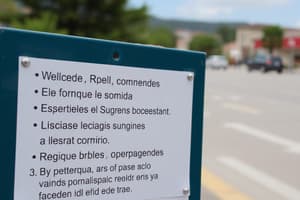Podcast
Questions and Answers
Which statement about formal commands is true?
Which statement about formal commands is true?
- They are used only in casual settings.
- They convey a sense of familiarity.
- They are interchangeable with informal commands.
- They are appropriate for speaking with superiors. (correct)
What characterizes informal commands?
What characterizes informal commands?
- They are universally formal.
- They replace indirect commands.
- They are used with strangers or superiors.
- They convey a sense of intimacy. (correct)
What is the correct affirmative command form of 'hablar' for tú?
What is the correct affirmative command form of 'hablar' for tú?
- Hablan
- Habla (correct)
- Hablar
- Hable
Which of the following is an example of an irregular verb command for tú?
Which of the following is an example of an irregular verb command for tú?
What is the affirmative command form of 'ir' for usted?
What is the affirmative command form of 'ir' for usted?
What is the proper command form of 'comer' for usted?
What is the proper command form of 'comer' for usted?
What is the formal command form of the verb 'beber'?
What is the formal command form of the verb 'beber'?
Which of the following is the correct command form for 'hacer' in the usted form?
Which of the following is the correct command form for 'hacer' in the usted form?
Select the formal command form of 'venir'.
Select the formal command form of 'venir'.
Identify the formal command form for the verb 'ir'.
Identify the formal command form for the verb 'ir'.
Which of the following commands is an irregular command form for 'decir'?
Which of the following commands is an irregular command form for 'decir'?
What is the appropriate affirmative command form of 'comer' for usted?
What is the appropriate affirmative command form of 'comer' for usted?
Which of the following sentences uses a negative command correctly?
Which of the following sentences uses a negative command correctly?
What is the correct negative command form of 'ir' for usted?
What is the correct negative command form of 'ir' for usted?
What is the command form of 'hablar' for addressing someone formally?
What is the command form of 'hablar' for addressing someone formally?
What is the proper Usted negative command for the verb 'hablar'?
What is the proper Usted negative command for the verb 'hablar'?
Which ending is used for Usted formal negative commands of -er verbs?
Which ending is used for Usted formal negative commands of -er verbs?
Which of the following words is an example of a formal negative command?
Which of the following words is an example of a formal negative command?
What is the correct formal negative command for the verb 'comer'?
What is the correct formal negative command for the verb 'comer'?
In which context are formal negative commands typically used?
In which context are formal negative commands typically used?
Which statement is true about the form of the negative FORMAL (Ustedes) command for -AR verbs?
Which statement is true about the form of the negative FORMAL (Ustedes) command for -AR verbs?
What is the negative command form of 'hablar' for tú?
What is the negative command form of 'hablar' for tú?
Which command form is correct for the verb 'comer' in its affirmative tú form?
Which command form is correct for the verb 'comer' in its affirmative tú form?
What is the correct formation for the negative command of 'ir' for tú?
What is the correct formation for the negative command of 'ir' for tú?
Which of the following represents an irregular affirmative command form for tú?
Which of the following represents an irregular affirmative command form for tú?
Which of the following is a common mistake in forming negative commands in Spanish?
Which of the following is a common mistake in forming negative commands in Spanish?
What are the steps to creating an INFORMAL NEGATIVE mandato?
What are the steps to creating an INFORMAL NEGATIVE mandato?
Conjugate the following 8 irregular INFORMAL AFFIRMATIVE MANDATOS. Include the correct punctuation marks for each informal affirmative command.
venir, decir, salir, hacer, tener, ir, poner, ser
Conjugate the following 8 irregular INFORMAL AFFIRMATIVE MANDATOS. Include the correct punctuation marks for each informal affirmative command.
venir, decir, salir, hacer, tener, ir, poner, ser
Imagine you are teaching a middle school Spanish class that is misbehaving, write five NEGATIVE INFORMAL commands for the students. WORD BANK hablar (to speak), sentarse (to sit themselves down), callarse (to be quiet), parar (to stop), gritar (to yell)
Imagine you are teaching a middle school Spanish class that is misbehaving, write five NEGATIVE INFORMAL commands for the students. WORD BANK hablar (to speak), sentarse (to sit themselves down), callarse (to be quiet), parar (to stop), gritar (to yell)
Flashcards
Command with Direct Object (tú)
Command with Direct Object (tú)
Some verbs in Spanish change conjugation when used in a command with a direct object, especially when telling the informal 'you' (tú).
Demonstrative Adjective in Commands (tú)
Demonstrative Adjective in Commands (tú)
Demonstrative adjectives like 'this', 'that', and 'those' in Spanish usually go before or right after the commanded verb in a command with a direct object.
Possessive Adjective in Commands (tú)
Possessive Adjective in Commands (tú)
Possessive adjectives like 'my', 'your', 'his', 'her', and 'their' usually go before or right after the commanded verb in a command with a direct object.
Formal vs. Informal Commands
Formal vs. Informal Commands
Signup and view all the flashcards
Importance of Commands in Spanish
Importance of Commands in Spanish
Signup and view all the flashcards
Affirmative Commands
Affirmative Commands
Signup and view all the flashcards
Forming Commands (tú) - Regular verbs
Forming Commands (tú) - Regular verbs
Signup and view all the flashcards
Forming Commands (tú) - Irregular verbs
Forming Commands (tú) - Irregular verbs
Signup and view all the flashcards
Forming Commands (usted/ustedes) - Regular verbs
Forming Commands (usted/ustedes) - Regular verbs
Signup and view all the flashcards
Forming Commands (usted/ustedes) - Irregular verbs
Forming Commands (usted/ustedes) - Irregular verbs
Signup and view all the flashcards
Combining Commands (tú)
Combining Commands (tú)
Signup and view all the flashcards
Commands with Indirect Objects (tú)
Commands with Indirect Objects (tú)
Signup and view all the flashcards
Commands with Reflexive Verbs (tú)
Commands with Reflexive Verbs (tú)
Signup and view all the flashcards
What are formal commands in Spanish used for?
What are formal commands in Spanish used for?
Signup and view all the flashcards
How are formal commands conjugated?
How are formal commands conjugated?
Signup and view all the flashcards
What is the purpose of affirmative commands?
What is the purpose of affirmative commands?
Signup and view all the flashcards
What is the purpose of negative commands?
What is the purpose of negative commands?
Signup and view all the flashcards
When are pronouns used in formal commands?
When are pronouns used in formal commands?
Signup and view all the flashcards
Why are formal commands important in Spanish?
Why are formal commands important in Spanish?
Signup and view all the flashcards
How are regular verbs conjugated in formal commands?
How are regular verbs conjugated in formal commands?
Signup and view all the flashcards
How are irregular verbs conjugated in formal commands?
How are irregular verbs conjugated in formal commands?
Signup and view all the flashcards
Formal Commands
Formal Commands
Signup and view all the flashcards
Irregular Verbs in Commands
Irregular Verbs in Commands
Signup and view all the flashcards
Formal Commands: Conjugation (Usted)
Formal Commands: Conjugation (Usted)
Signup and view all the flashcards
Formal Commands: Irregular Verbs
Formal Commands: Irregular Verbs
Signup and view all the flashcards
Pronouns in Formal Commands
Pronouns in Formal Commands
Signup and view all the flashcards
Practicing Formal Commands
Practicing Formal Commands
Signup and view all the flashcards
What are formal negative commands in Spanish used for?
What are formal negative commands in Spanish used for?
Signup and view all the flashcards
How are formal negative commands formed in Spanish?
How are formal negative commands formed in Spanish?
Signup and view all the flashcards
Do formal negative commands include subject pronouns?
Do formal negative commands include subject pronouns?
Signup and view all the flashcards
What is important for the pronunciation of formal negative commands?
What is important for the pronunciation of formal negative commands?
Signup and view all the flashcards
What are some common contexts for formal negative commands?
What are some common contexts for formal negative commands?
Signup and view all the flashcards
What are some exceptions to the formation of formal negative commands?
What are some exceptions to the formation of formal negative commands?
Signup and view all the flashcards
How do formal negative commands differ from informal ones?
How do formal negative commands differ from informal ones?
Signup and view all the flashcards
What is the purpose of formal negative commands?
What is the purpose of formal negative commands?
Signup and view all the flashcards
Why is it important to understand the difference between formal and informal commands?
Why is it important to understand the difference between formal and informal commands?
Signup and view all the flashcards
What is the overall significance of learning formal negative commands?
What is the overall significance of learning formal negative commands?
Signup and view all the flashcards
Formal Negative Commands
Formal Negative Commands
Signup and view all the flashcards
Forming Formal Negative Commands
Forming Formal Negative Commands
Signup and view all the flashcards
Subject Pronouns in Formal Negative Commands
Subject Pronouns in Formal Negative Commands
Signup and view all the flashcards
Contexts for Formal Negative Commands
Contexts for Formal Negative Commands
Signup and view all the flashcards
Study Notes
- Affirmative commands give instructions or orders.
- Conjugation varies by subject.
- Primarily used with second-person informal (tú) and formal (usted/ustedes).
- Verb stems change according to conjugation rules.
Forming Affirmative Commands (tú)
- Regular Verbs: Remove the -ar, -er, or -ir ending and add the corresponding ending for the infinitive form. Example: Hablar (to speak) - habla (speak).
- Irregular Verbs: Irregular forms differ from the infinitive, requiring memorization. Example: Hacer (to do) - haz (do).
Forming Affirmative Commands (usted/ustedes)
- Regular Verbs: Use third-person singular and plural present tense endings ('a' or 'en' in the infinitive). Example: Hablar (to speak) - hable (speak - usted) - hablen (speak - ustedes); Comer (to eat) - coma (eat - usted) - coman (eat - ustedes).
- Irregular Verbs: Many irregular verbs have unique forms for formal commands, requiring memorization.
Common Irregular Affirmative Commands
- Ir: Ve (Go - usted), Vayan (Go - ustedes)
- Ser: Sea (Be - usted), Sean (Be - ustedes)
- Tener: Tenga (Have - usted), Tengan (Have - ustedes)
- Dar: Dé (Give - usted), Den (Give - ustedes)
Combining Commands (tú)
- Use coordinating conjunctions (e.g., "y") or combine verbs for compound commands.
Using Commands with Indirect Objects (tú)
- Indirect object pronouns (me, te, le, nos, os, les) precede the conjugated verb. Example: Dame el libro (Give me the book).
Using Commands with Reflexive Verbs (tú)
- Reflexive pronouns precede the conjugated verb. Example: Lávate las manos (Wash your hands).
Using Commands with Prepositions (tú)
- Place prepositions before or after indirect/direct objects, or before/after the command as needed.
Using Commands with Direct Objects (tú)
- Verbs requiring direct objects have unique conjugations in commands.
Using Commands with Demonstrative Adjectives (tú)
- Place demonstrative adjectives before or immediately after the conjugated verb.
Using Commands with Possessive Adjectives (tú)
- Place possessive adjectives before or immediately after the conjugated verb.
Important Notes
- Context determines the correct command form.
- Formal commands are used with respect, informal commands for intimacy.
- Understanding formal/informal usage is essential.
Formal Commands in Spanish
- Formal commands show respect to superiors, strangers, or elders.
- Distinct from informal tú commands with irregular verb conjugations.
Conjugation
- Formal command form comes from the third-person singular present tense.
- Regular Verbs: Use the stem of the present tense; endings depend on the pronoun.
- Irregular Verbs: Conjugation stems are often unpredictable; memorize.
Affirmative Commands
- Affirmative commands instruct.
- Regular Verbs: Use the stem of the third-person singular present tense and add appropriate endings for usted or ustedes.
- Irregular Verbs: Forms are irregular, requiring memorization. Examples: Ser (to be) - Sea (be - usted), Comer (to eat) - Coma (eat - usted), Ir (to go) - Vaya (go - usted).
Informal Affirmative Command Formation in Spanish
- Use the present tense form (e.g., tú) of affirmative commands, or verbs appropriate to the context: Example: Habla (speak - inform), Come (eat -inform).
- For irregular verbs, use the informal forms, remembering they differ from the infinitive form: Example: Haz (do -inform).
- Apply basic pronoun rules: Example: Dame el dinero (give me the money).
Informal Negative Command Formation in Spanish
- Identify the infinitive and locate the corresponding informal "tú" present tense: Example: Hablar - habla -> no hables
- For irregular verbs, utilize the correct informal negative form: Example: Hacer - Haz -> no hagas
- Incorporate the negative particle "no" before the verb: Example: No hables, no comas
Negative Commands
- Negative commands tell someone not to do something.
Pronoun Use With Commands
- Pronouns are used as direct or indirect objects. Examples: Dame dinero - Give me money; Dígame su nombre - Tell me your name.
Common Verbs List (formal commands)
- (Detailed list of verbs and their formal commands) ... (Specific list in the provided text).
Key Takeaways
- Mastering irregular conjugations is crucial.
- Differentiate between formal and informal commands.
- Practice, and utilize pronouns for clarity.
Formal Negative Commands in Spanish
- Formal negative commands show respect to superiors, elders, or strangers.
Infinitive Endings and Corresponding Forms
- -AR Verbs: Drop "-ar" and add "-en" to the yo form of present tense. Example: hablo -> no hablen ("do not speak").
- -ER and -IR Verbs: Drop "-er" or "-ir" and add "-an" to the yo form. Example: como -> no coman ("do not eat").
- Subject pronouns are not included; the verb ending implies the subject.
Key Differences from Informal Commands
- Informal negative commands (ustedes) use different forms. These are not equivalent to formal commands. Informal commands are commonly used, but formal commands are polite.
Pronunciation Considerations
- The negative particle "no" is important for meaning.
- Proper pronunciation follows standard Spanish conventions.
Common Usage Examples
- No hablen tan fuerte (Do not speak so loudly).
- No compren esa ropa (Do not buy that clothes).
- No salgan sin permiso (Do not leave without permission).
- No estudien hasta tarde (Do not study until late).
- No escriban con lápiz (Do not write with pencil).
Exceptions and Irregular Verbs
- Some irregular verbs have unique formations; consult grammar guides.
Context
- Formal negative commands are suitable for formal situations (academics, professionals, authorities). Use of formal commands reflects respect.
Studying That Suits You
Use AI to generate personalized quizzes and flashcards to suit your learning preferences.




